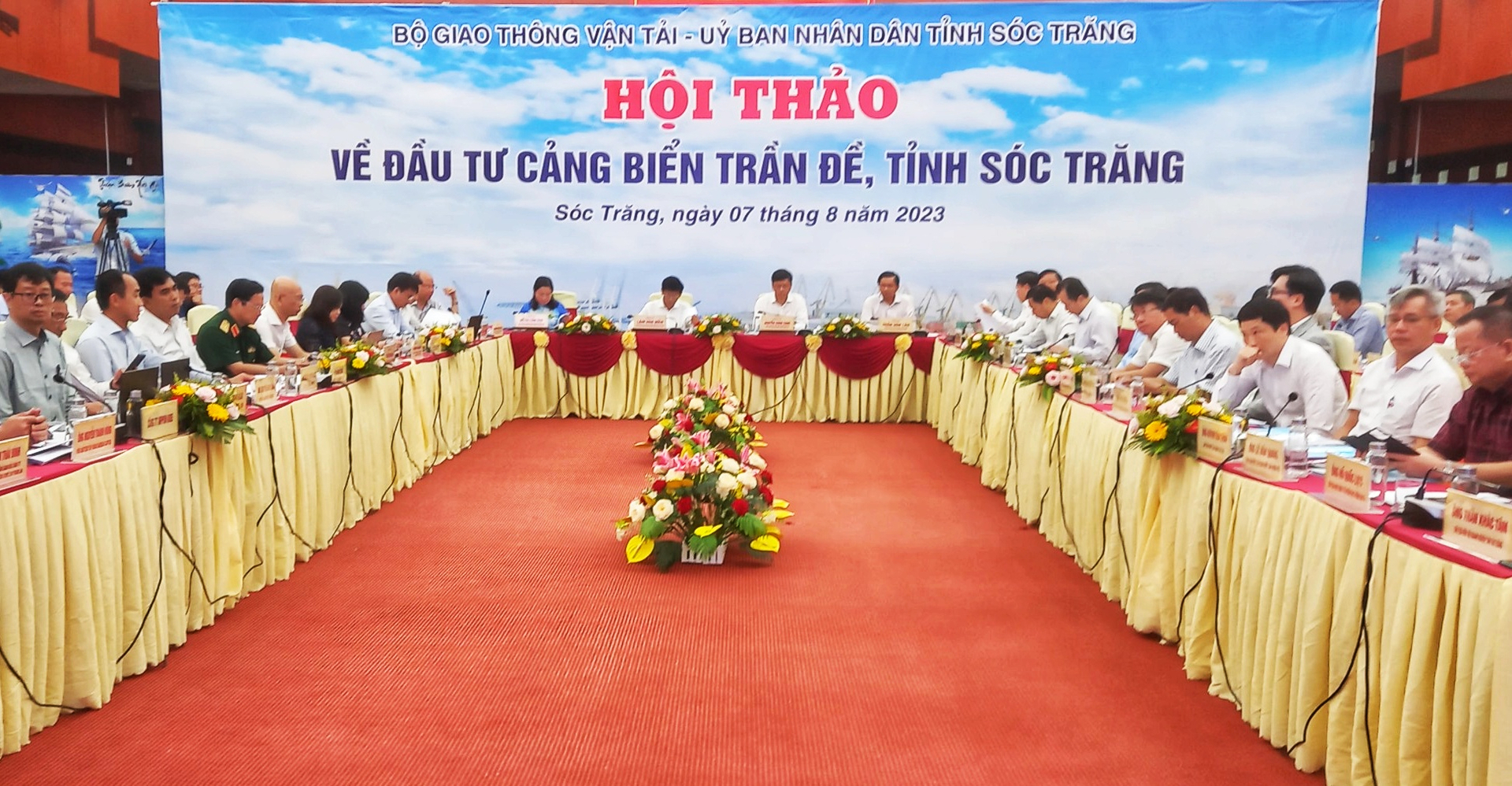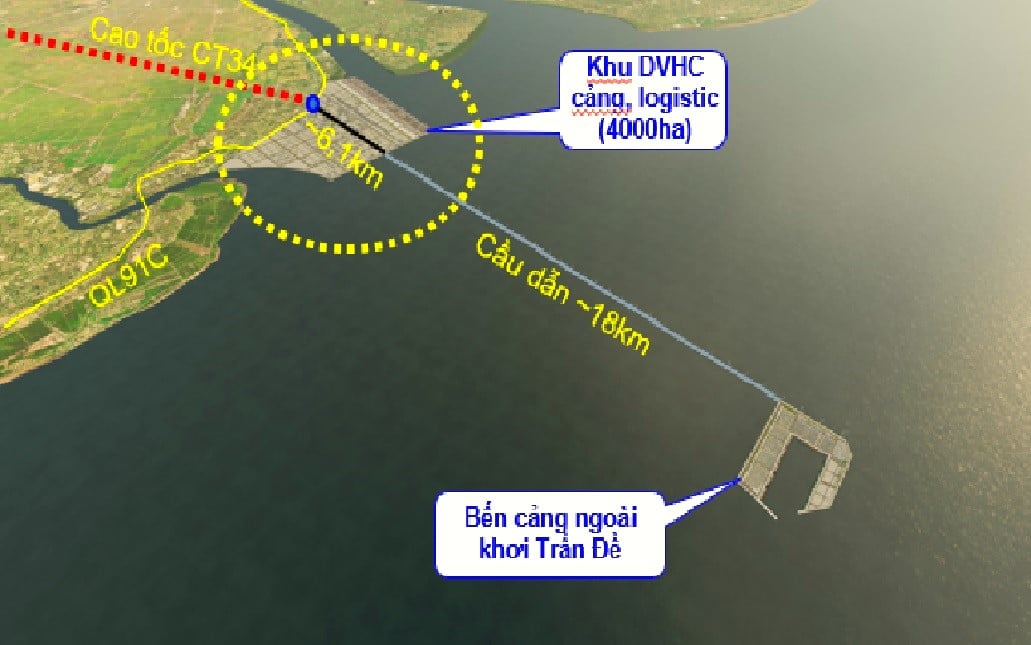June 19, 2025 | 07:17 GMT +7
June 19, 2025 | 07:17 GMT +7
Hotline: 0913.378.918
June 19, 2025 | 07:17 GMT +7
Hotline: 0913.378.918

The total annual import and export volume of the Mekong Delta is about 21-22 million tons, accounting for a large proportion of rice, seafood and vegetables. Photo: Kim Anh.
The draft plan for Tran De Seaport in Soc Trang province reveals that the total annual volume of goods imported and exported from the Mekong Delta region is around 21 - 22 million tons, with a significant proportion being rice, aquatic products, and fruits and vegetables. However, less than 10% of the cargo is directly transported through the region's seaports, while the remainder has to be transshipped to ports in Ho Chi Minh City, Ba Ria – Vung Tau, Dong Nai, etc., before being sent to other countries.
Recently, during a seminar on the investment in Tran De Seaport, many businesses evaluated that investing in the construction and operation of this gateway port for the Mekong Delta region in Tran De district, Soc Trang province, will provide a strong impetus and significant breakthrough for the area in the coming time. Particularly, Tran De Seaport plays a pivotal role in reducing costs for businesses and residents in the Mekong Delta region.

At the seminar on investment in Tran De seaport, Soc Trang province, businesses expressed that if Tran De seaport is built and put into operation, it is the key to cutting down on costs. Photo: Kim Anh.
Mr. Pham Thai Binh, CEO of Trung An Hi-Tech Farming Joint Stock Company, believes that in the Mekong Delta region, there are several ports such as Cai Cui Port in Can Tho City, My Thoi Port in An Giang Province, Cao Lanh Port in Dong Thap Province, and Long An Port. However, these ports primarily operate as river ports, serving the purpose of transshipment of goods or accommodating small-tonnage vessels. Businesses within the region are forced to handle cargo transshipment in Ho Chi Minh City, leading to additional costs.
For instance, at Trung An Company, an annual export volume of approximately 200,000 tons of rice is handled. The majority of this rice does not get processed at ports in the Mekong Delta but has to be transshipped at ports in Ho Chi Minh City. If Tran De Seaport is constructed, Mr. Binh estimates that the transshipment fees from the Mekong Delta region localities to Tran De Port would be reduced by about 40% compared to transshipment to Ho Chi Minh City. This translates to hundreds of millions of US dollars in annual savings.
Mr. Ho Quoc Luc, Chairman of the Board of Directors of Sao Ta Food Joint Stock Company, also shared his perspective. Over the course of 27 years in operation, the company's cargo transportation has been focused on Cai Mep and Cat Lai ports in Ho Chi Minh City. Due to the long distance and high traffic density, round-trip transportation costs the company around 700 USD per 40-foot container. The most concerning issue is the potential risks associated with the long distance, which could result in delayed cargo arrival at the port.
Therefore, Mr. Luc concurs that the construction of Tran De Seaport would support businesses in multiple aspects and enhance reliability with partners in cargo handling. Currently, Sao Ta Company exports around 1,500 refrigerated 40-foot containers annually. With Tran De Seaport, the company could reduce transportation costs by at least 15 billion VND per year.
Furthermore, with the establishment of Tran De Seaport, both local and external investors in the Mekong Delta region would invest in constructing supplementary facilities around the port, such as cold storage warehouses, processing plants, fuel storage facilities, and liquefied gas facilities. This would help reduce both costs and the time required for loading and unloading goods for import and export.

Estimated planning of Tran De seaport area on the shore, logistics area, logistics in the start-up phase. Photo: Kim Anh.
The draft plan for the development of Tran De Seaport in Soc Trang Province, undertaken by the Construction Consultation Joint Stock Company for Maritime Building (CMB), indicates that the deep-water port area of Tran De covers an expansive 5,400 hectares. Within this, the project will construct an offshore port with an area of 1,400 hectares, capable of accommodating container ships up to 100,000 tons. This offshore port will be linked to the shore via an 18-kilometer-long system of sea-crossing bridges.
The development plan for Tran De Seaport also outlines an investment in the construction of a system of 15 port bridges, totaling 5.5 kilometers in length, and an 8.3-kilometer-long wave barrier system. By 2030, there will be six port bridges spanning 2.2 kilometers and a 6.1-kilometer wave barrier system.
The Tran De Seaport project is estimated to require a total investment of over 51.3 trillion VND (by 2030) and a comprehensive investment of nearly 145.3 trillion VND by 2050. During the period leading up to 2030, around 34 trillion VND will be invested in infrastructure construction components, including sea-crossing bridges, equipment, wave barriers, maritime traffic flow systems, and signaling.
Mr. Tran Van Lau, Chairman of the People's Committee of Soc Trang Province, stated that Tran De Seaport will serve as an integral piece for the synchronized development of transportation infrastructure in the Mekong Delta region. Provincial leadership has introduced numerous preferential policies and invited investors to participate in Tran De Seaport. Some attractive incentive policies implemented by the province include: a preferential tax rate of 10% for 15 years; a tax exemption for 4 years and a 50% reduction in taxes for the following 9 years; exemption from land and water surface rental fees during the leasing period, or tax exemption for imported goods used to create fixed assets.
Upon its establishment, Tran De Seaport will significantly reduce transportation costs by 30-40% for goods exported and imported by the 8 southern provinces along the Tien River, both for road and inland waterway transport. Additionally, a considerable volume of goods currently transported from the Cambodia region along the Mekong inland waterway to ports in the Southeastern region will shift to Tran De Seaport due to its strategic location advantage.
According to the projected plan for Tran De Seaport, the total volume of cargo passing through the offshore port by 2030 will range from 24 to 32 million tons, including approximately 11.6 to 16.3 million tons of container cargo. This encompasses cargo destined for North America and Europe, as well as goods for import and export serving transportation routes across Northeast Asia and Southeast Asia.
On July 24, 2023, the Prime Minister of the Government issued Decision No. 886/QD-TTg approving the Plan, policies, solutions, and resources for the implementation of the overall development plan for the Vietnam seaport system for the period 2021 - 2030, with a vision to 2050.
Within this, businesses are encouraged to invest in the Tran De Seaport – Soc Trang (Initiation Phase) with a capital of 50,000 billion VND.
Translated by Nguyen Hai Long
![Turning wind and rain into action: [9] Digitizing hydrometeorological data in response to climate change](https://t.ex-cdn.com/nongnghiepmoitruong.vn/608w/files/news/2025/06/17/z6704423696987_15fd32ffc26d590d204d520c9dac6786-nongnghiep-165943.jpg)
(VAN) Farmers have begun accessing hydrometeorological applications to adjust their cropping schedules, aiming to ensure productivity and adapt to climate change.
![Turning wind and rain into action: [8] Real-time salinity detection and early warning technology](https://t.ex-cdn.com/nongnghiepmoitruong.vn/608w/files/news/2025/06/17/z6704423696987_15fd32ffc26d590d204d520c9dac6786-nongnghiep-151127.jpg)
(VAN) Thanks to the integration of modern hydrological-hydraulic models, remote sensing technologies, and artificial intelligence, the accuracy of hydrological forecasting has significantly improved.
![Turning wind and rain into action: [7] Early disaster warnings help marine farmers minimize losses](https://t.ex-cdn.com/nongnghiepmoitruong.vn/608w/files/news/2025/06/17/z6704423696987_15fd32ffc26d590d204d520c9dac6786-nongnghiep-142942.jpg)
(VAN) In recent years, thanks to early disaster warnings and forecasting, marine farmers in Khanh Hoa province have been able to reduce risks and losses, thereby improving production efficiency.
![Turning wind and rain into action: [6] ‘Four on-the-spot’ disaster management software](https://t.ex-cdn.com/nongnghiepmoitruong.vn/608w/files/news/2025/06/17/e5a48259d6a262fc3bb3-nongnghiep-183800.jpg)
(VAN) By simply activating the scenario on the disaster management software, the relevant authorities immediately know how many households need to be evacuated, where to evacuate them to, and by what means of transportation…
![Turning wind and rain into action: [5] Hue applies modern technology in disaster forecasting](https://t.ex-cdn.com/nongnghiepmoitruong.vn/608w/files/news/2025/06/17/z6704423696987_15fd32ffc26d590d204d520c9dac6786-nongnghiep-093938.jpg)
(VAN) In Hue city, modern technology has recently been applied in meteorological and hydrological forecasting and warning, helping to reduce the damage caused by natural disasters.

(VAN) A cutting-edge farming technique being implemented on an experimental ranch in Arizona's Sonoran Desert has already saved a billion gallons of water over five years, according to Civil Eats.

(VAN) Poultry and pig production and the environment can be boosted through enhanced water technology, according to new research.